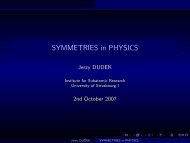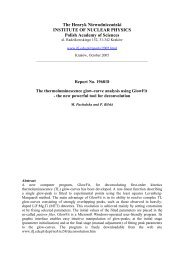2045/D - Instytut Fizyki JÄ drowej PAN
2045/D - Instytut Fizyki JÄ drowej PAN
2045/D - Instytut Fizyki JÄ drowej PAN
Create successful ePaper yourself
Turn your PDF publications into a flip-book with our unique Google optimized e-Paper software.
Barbara Obryk rozprawa doktorska - 3 -<br />
Development of a method for measurement of high doses<br />
of ionizing radiation using highly sensitive LiF:Mg,Cu,P<br />
thermoluminescent detectors<br />
Abstract<br />
One of the well known advantages of thermoluminescence (TL) detectors made of<br />
lithium fluoride doped with magnesium, copper and phosphorus (LiF:Mg,Cu,P) is their very<br />
high sensitivity to ionizing radiation. LiF:Mg,Cu,P detectors enable measurements of radiation<br />
doses from tens of nanograys up to a few kilograys, when the total saturation of the signal of the<br />
so-called main dosimetric peak (at about 220°C) occurs. In 2006 for the first time the author<br />
observed unprecedented high-temperature emission of LiF detectors heated to temperatures up<br />
to 600°C, after exposures to radiation doses ranging from 1 kGy to 1 MGy. For quantification of<br />
the glow curve shape changes of LiF:Mg,Cu,P detectors in this range of doses and<br />
determination of the absorbed dose, the high temperature coefficient (UHTR) was defined.<br />
This newly established dosimetric method was tested in a range of radiation qualities,<br />
such as gamma radiation, electron and proton beams, thermal neutron fields and in high-energy<br />
mixed fields around the SPS and PS accelerators at CERN. A number of dosimetric sets with<br />
LiF:Mg,Cu,P detectors are currently installed around the LHC at CERN. The new method for<br />
ultra-high dose range monitoring with a single LiF:Mg,Cu,P detector, which is capable of<br />
covering at least twelve orders of magnitude of doses, can be used for dosimetry at high energy<br />
accelerators, thermonuclear fusion technology facilities and has great potential for accident<br />
dosimetry in particular.
















